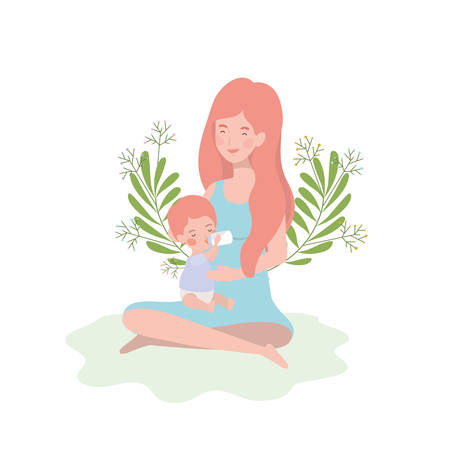1. Physical and Emotional Changes
The second trimester is often called the “honeymoon phase” of pregnancy because many moms-to-be start feeling better compared to the first trimester. Morning sickness tends to fade, and your energy levels may increase. However, your body continues to change, and you might notice new symptoms as your baby grows.
Common Physical Changes
During this trimester, your body adapts to support your growing baby. Below are some common physical changes you may experience:
| Physical Change | Description |
|---|---|
| Increased Energy | You may feel more energetic compared to the first trimester, making daily activities easier. |
| Baby Movements | Around weeks 18-22, you might start feeling little flutters or kicks from your baby. |
| Growing Belly | Your bump becomes more noticeable as your uterus expands. |
| Skin Changes | You might develop a pregnancy glow or notice dark patches on your skin (melasma). |
| Round Ligament Pain | You may feel sharp pains in your lower belly or hips as ligaments stretch to support your uterus. |
| Nasal Congestion | Pregnancy hormones can cause increased blood flow to mucous membranes, leading to stuffy noses. |
| Braxton Hicks Contractions | You may start experiencing mild, irregular contractions as your body prepares for labor. |
Emotional Shifts
Your emotions may fluctuate during the second trimester due to hormonal changes and the excitement of feeling your baby move for the first time. Some women feel more relaxed and happy, while others may still experience mood swings or anxiety about the upcoming birth.
Coping with Emotional Changes
- Talk About Your Feelings: Share any concerns with your partner, friends, or a healthcare provider.
- Pamper Yourself: Take time for self-care activities like prenatal yoga, warm baths, or relaxing walks.
- Create a Support System: Connecting with other expecting moms can help you feel supported and understood.
- Meditation and Deep Breathing: These techniques can help reduce stress and improve overall well-being.
The Exciting Milestone: Feeling Baby Move
Around the middle of this trimester, youll likely experience one of the most exciting moments—feeling your baby move! At first, it may feel like tiny flutters or bubbles, but as weeks go by, those movements become stronger and more defined. If its your first pregnancy, you might not recognize them right away, but soon enough, youll learn to distinguish those little kicks and rolls.
When to Expect Baby Movements?
- Around 18-22 weeks: First-time moms usually start feeling movement within this range.
- Around 16-18 weeks: If youve been pregnant before, you might notice movements earlier.
- Lying down quietly: You’re more likely to feel movements when youre relaxed and paying attention.
- If concerned: If you havent felt movement by week 24, talk to your doctor for reassurance.
The second trimester is an exciting time filled with changes—both physically and emotionally. By understanding what to expect and how to manage these shifts, you can enjoy this phase of pregnancy with confidence!
2. Prenatal Appointments and Tests
Your second trimester is an exciting time filled with important prenatal appointments and screenings. These visits help ensure both you and your baby are healthy as your pregnancy progresses.
Key Prenatal Visits
During the second trimester, youll typically have an OB appointment every four weeks. These check-ups allow your doctor to monitor your health, track your babys growth, and address any concerns you may have.
What Happens at Your OB Appointments?
- Weight and Blood Pressure Check: Your doctor will monitor your weight gain and blood pressure to ensure theyre within a healthy range.
- Fundal Height Measurement: This measures the growth of your uterus to track your babys development.
- Babys Heartbeat: Youll get to hear your babys heartbeat using a Doppler device—an exciting moment for many parents!
- Discussion of Symptoms: Your doctor will ask about any symptoms youre experiencing and provide guidance on managing them.
Important Second Trimester Screenings
Certain tests during this trimester help assess your babys development and screen for potential complications. Here are some key screenings to expect:
| Test | Purpose | When Its Done |
|---|---|---|
| Anatomy Scan (20-Week Ultrasound) | A detailed ultrasound to check your babys organs, limbs, and overall growth. | Around 18-22 weeks |
| Glucose Screening Test | Screens for gestational diabetes by measuring how your body processes sugar. | Around 24-28 weeks |
| Quad Screen | A blood test that assesses the risk of chromosomal abnormalities and neural tube defects. | Around 15-20 weeks |
| NIPT (Non-Invasive Prenatal Testing) | A blood test that screens for genetic conditions like Down syndrome. | Around 10-22 weeks (optional) |
The Anatomy Scan: A Major Milestone
The anatomy scan is one of the most anticipated ultrasounds of pregnancy. During this detailed scan, the technician checks your babys heart, brain, spine, kidneys, and other organs. Its also when many parents find out their babys gender—if they choose to!
What to Expect During the Scan?
- The ultrasound usually takes 30-45 minutes.
- You may need a full bladder for better imaging.
- If the baby is in a tricky position, you might be asked to move around or come back later.
- Your provider will discuss results or schedule a follow-up if needed.
Your Role in Prenatal Care
Prenatal appointments are not just about tests; they’re also an opportunity to ask questions and prepare for the next stages of pregnancy. Keep track of any symptoms or concerns between visits so you can discuss them with your doctor.

3. Nutrition and Fitness for a Healthy Pregnancy
During the second trimester, your baby is growing rapidly, and your body needs extra nutrients and physical activity to support a healthy pregnancy. Eating a balanced diet and staying active can help you feel your best while ensuring your baby gets the essential nutrients needed for development.
Best Foods to Eat During the Second Trimester
A well-rounded diet is crucial for both you and your baby. Focus on nutrient-dense foods that provide essential vitamins and minerals.
| Food Group | Best Choices |
|---|---|
| Protein | Lean meats, eggs, beans, lentils, tofu, and nuts |
| Dairy | Greek yogurt, milk, cheese, and fortified plant-based alternatives |
| Fruits & Vegetables | Berries, leafy greens, carrots, sweet potatoes, avocados |
| Whole Grains | Quinoa, brown rice, whole wheat bread, oats |
| Healthy Fats | Nuts, seeds, olive oil, avocado, salmon |
Essential Nutrients for a Healthy Pregnancy
Certain nutrients are especially important in the second trimester to support your babys growth.
- Folic Acid: Helps prevent birth defects. Found in leafy greens, citrus fruits, and fortified cereals.
- Iron: Supports increased blood volume. Found in lean meats, beans, spinach, and fortified grains.
- Calcium: Strengthens bones and teeth. Found in dairy products and green vegetables.
- DHA (Omega-3): Supports brain development. Found in salmon, walnuts, and flaxseeds.
- Protein: Essential for muscle and tissue growth. Found in eggs, poultry, fish, and legumes.
Safe Exercises to Stay Active
Mild to moderate exercise can boost energy levels, reduce discomforts like back pain, and prepare your body for labor. Always check with your doctor before starting any new workout routine.
The Best Exercises for the Second Trimester:
- Prenatal Yoga: Helps with flexibility and relaxation.
- Walking: A low-impact way to keep moving without strain.
- Swimming: Reduces pressure on joints while providing a full-body workout.
- Kegel Exercises: Strengthens pelvic floor muscles for better bladder control.
- Pilates: Improves posture and core strength safely during pregnancy.
Lifestyle Tips for a Healthy Pregnancy
Apart from eating well and exercising regularly, these simple lifestyle habits can help maintain your well-being throughout the second trimester:
- Stay Hydrated: Aim for at least 8-10 glasses of water per day to support circulation and amniotic fluid levels.
- Avoid Processed Foods: Limit sugary snacks and processed meals that can cause unnecessary weight gain.
- Pace Yourself: Rest when needed and listen to your body’s signals.
- Sit Comfortably: Use pillows or cushions to support your back when sitting or lying down.
- Mental Well-being: Practice deep breathing or meditation to reduce stress levels.
Nourishing your body with the right foods and staying active will help you feel strong as you move through the second trimester. By focusing on balanced nutrition and safe exercises, youre setting yourself up for a healthy pregnancy journey!
4. Preparing for Baby: Registry and Nursery Setup
Getting ready for your little one’s arrival can feel overwhelming, but planning ahead will make the transition smoother. Now that youre in your second trimester, its the perfect time to start your baby registry and set up the nursery. Heres how to get started.
Creating Your Baby Registry
A baby registry helps friends and family know what you need, and it ensures you have all the essentials before your baby arrives. Consider registering at stores like Target, Amazon, or Buy Buy Baby, which offer completion discounts and free welcome gifts.
Must-Have Items for Your Registry
| Category | Essential Items |
|---|---|
| Nursery | Crib, crib mattress, changing table, rocking chair |
| Diapering | Diapers (newborn & size 1), wipes, diaper cream, diaper pail |
| Feeding | Bottles, breast pump (if needed), burp cloths, high chair |
| Clothing | Bodysuits, sleepers, socks, hats, mittens |
| Travel | Infant car seat, stroller, diaper bag, baby carrier |
| Bathing & Health | Baby bathtub, baby shampoo, nail clippers, thermometer |
| Toys & Soothing | Pacifiers, swaddle blankets, soft toys, white noise machine |
Nesting: Setting Up the Nursery
Your babys nursery should be a safe and comfortable space. Start with the basics like a crib and storage solutions. A well-organized nursery makes daily routines easier.
Nursery Setup Tips
- Create a Sleep-Friendly Space: Use blackout curtains and a white noise machine to help your baby sleep better.
- Add Storage Solutions: Baskets and bins keep diapers, clothes, and toys organized.
- Select a Comfortable Chair: A rocking chair or glider makes late-night feedings more manageable.
- Keeps Essentials Within Reach: Place diapers, wipes, and onesies near the changing station for easy access.
- Add Personal Touches: Decorate with soft colors and meaningful items to create a cozy environment.
The Best Time to Set Up Your Nursery
The second trimester is ideal for nursery setup because you still have energy and mobility. Start early so you’re not rushing in the third trimester. Aim to have everything ready by week 30-34 of pregnancy.
Avoiding Common Registry & Nursery Mistakes
- Avoid Overbuying Newborn Clothes: Babies grow quickly! Stick to essentials in newborn and 0-3 month sizes.
- Diversify Diaper Sizes: Don’t stock up on too many newborn diapers—your baby may outgrow them fast.
- Simplify Your Nursery Layout: Keep it functional with only the necessities to avoid clutter.
- Select Practical Items: Register for items that fit your lifestyle rather than trendy but impractical products.
- Safety First: Avoid loose bedding or pillows in the crib to reduce SIDS risk.
Tackling your baby registry and nursery now will save stress later. By planning ahead and choosing practical items, youll be well-prepared when your little one arrives!
5. Bonding with Your Baby
As your baby grows during the second trimester, you have a wonderful opportunity to start building a strong connection. Even though your little one is still in the womb, they can hear your voice, respond to sounds, and even sense your emotions. Taking time to bond now can create a foundation for a lifelong relationship.
Talking to Your Baby
Your baby begins to hear sounds around the 18th week of pregnancy, and by the 25th week, they may even recognize familiar voices. Talking to your baby regularly can help them become familiar with your voice, which can be soothing both before and after birth.
Ways to Talk to Your Baby:
- Read a book out loud – Choose childrens books or anything that brings you joy.
- Describe what youre doing – Talk about your day as if youre having a conversation with your baby.
- Sing lullabies or your favorite songs – Your baby will start recognizing patterns and rhythms.
Playing Music for Your Baby
Music has been shown to have positive effects on fetal development. Soft, calming music can be particularly beneficial for relaxation and bonding.
Best Types of Music for Your Baby:
| Music Type | Benefits |
|---|---|
| Classical Music | Encourages brain development and relaxation. |
| Lullabies | Create a sense of security and comfort. |
| Your Favorite Songs | Makes bonding more personal and enjoyable for you. |
Enjoying Mindful Moments Together
Taking time each day to relax and focus on your baby can help strengthen your bond. Mindfulness practices allow you to connect emotionally while also reducing stress.
Simple Ways to Practice Mindfulness:
- Meditation: Sit quietly, place your hands on your belly, and focus on your breathing.
- Prenatal Yoga: Gentle stretching and movements help you feel connected to your body and baby.
- Belly Massage: Lightly rub your belly with lotion or oil while thinking loving thoughts about your baby.
The second trimester is an exciting time as you begin to feel more connected with your growing baby. Through talking, music, and mindfulness, you can create a special bond that continues long after birth.


